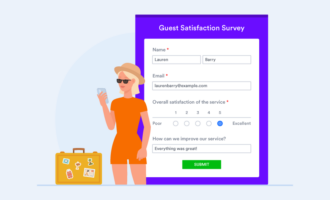Tips to calculate customer experience
- Net Promoter Score®
- Customer satisfaction scores
- Churn rate
- Customer Effort Score
Everyone likes to think that their business delivers a great service to customers and offers a product people shout about. Few actually do, though.
Luck isn’t what separates the companies that get this kind of reaction from those that don’t — a relentless focus on the customer experience is.
The customer experience — and why you should measure it
The customer experience can involve a lot of different things, says customer experience futurist Blake Morgan, but it essentially comes down to how consumers perceive your business. “Even if you think your brand and customer experience is one thing, if the customer perceives it as something different, that is what the actual customer experience is.”
Delivering a great customer experience is essential. The happier your customers are, the more likely they are to continue using your brand and recommend it to friends, family, and colleagues.
But in order to improve your customer experience, you first need to measure it.
Customer experience metrics are useful in several ways, says Gartner’s Susan Moore: “They can be used to communicate the rationale for previous investments; validate whether improvements have taken place; set goals and targets for future improvements; or intervene when remedial action is needed.”
4 metrics to calculate customer experience
There are several ways to calculate your customer experience, whether you’re using questionnaires, polls, surveys, or other feedback forms. Below are four of the most popular methods.
Net Promoter Score®
The Net Promoter Score (NPS) measures how likely consumers are to recommend your brand to family and friends. This metric boils down to asking customers one question: How likely are you to recommend [our product/service/company] to friends or colleagues?
Customers rate their responses on a scale from 0–10, with 0 being “not at all” and 10 being “extremely likely.” Anyone who gives your brand a 6 or below is a detractor; 7 and 8 are neutral; and anyone who awards you a 9 or 10 is a promoter. You can calculate your NPS by subtracting the percentage of detractors from the percentage of promoters.
Customer satisfaction scores
A customer satisfaction score (CSAT) is a measure of how satisfied customers are with your brand. Again, the metric is based on a single question: How satisfied are you with [our product, service, or company]?
In this case, customers typically use a scale from 1–5 to respond, with 5 being “very satisfied.” Marketers can tally the top two scores (4 and 5) and divide them by the total number of answers to work out their CSAT as a percentage.
This method is a great way to understand how happy customers are as a whole, but it also reveals how their satisfaction levels differ at different times of the year. For instance, dissatisfaction during the holiday shopping period could suggest your store has problems or you’re not offering enough discounts.
Churn rate
Your churn rate is simply the number of customers who don’t renew their subscription or buy another product over a certain period of time. This metric tends to be more important for SaaS businesses, but e-commerce stores should also consider it.
You don’t need to collect any additional data to calculate this customer experience metric. Simply divide the number of customers who have left your brand by the total amount of customers over a given time frame.
Customer Effort Score
The Customer Effort Score (CES) measures how easy it is for consumers to interact with your brand. Once again, you ask customers a single question, such as, “How easy was it to place your order today?”
Customers rate their experience on a numbered scale similar to the CSAT and NPS metrics, typically on a scale of 1–5, with the top number representing “very easy.” Calculate CES as a percentage by dividing the total number of people who answered “easy” or “very easy” by the total number of respondents. Alternatively, you can look at the spread of answers by subtracting the percentage that gave you a score of 4 or 5 from the percentage that gave you a 1 or 2.

How to collect customer data
The metrics above are nothing without actual data, and there are few methods better at capturing that data than surveys. We recommend using Jotform to send surveys automatically at specific points of the customer journey to gather quantitative and qualitative feedback.
When creating your survey, make sure you tailor the questions to your desired goal and the KPI you’re using. For instance, if you’re trying to determine your customer satisfaction score, don’t bombard customers with irrelevant questions about how likely they are to recommend your product or how easy it was to place an order. The less you ask of them, the more likely they are to respond.
Net Promoter®, NPS®, NPS Prism®, and the NPS-related emoticons are registered trademarks of Bain & Company, Inc., NICE Systems, Inc., and Fred Reichheld. Net Promoter ScoreSM and Net Promoter SystemSM are service marks of Bain & Company, Inc., NICE Systems, Inc., and Fred Reichheld.






































































































Send Comment: